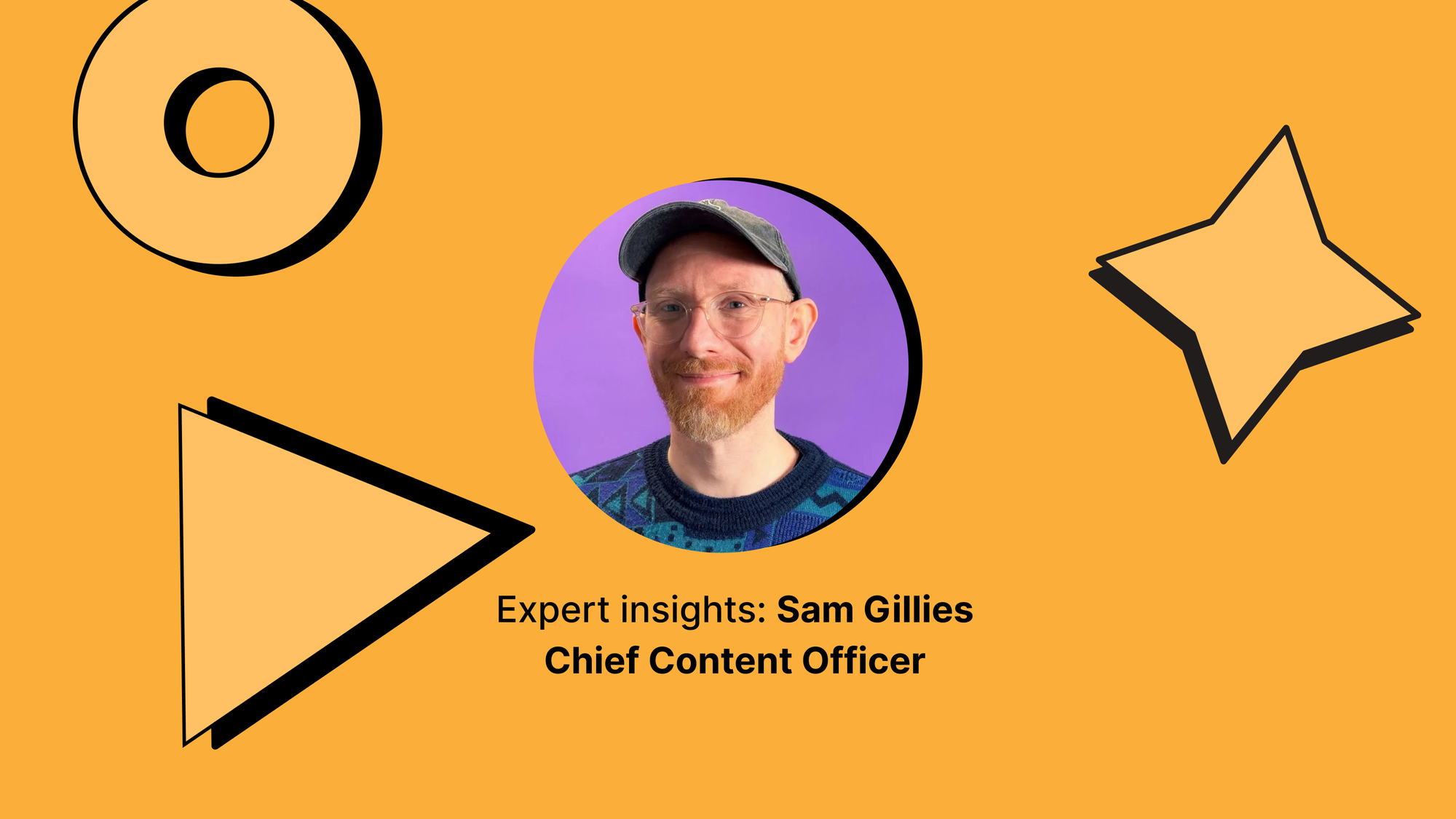B2B Influencer Marketing: A Comprehensive Guide On How To Grow Your Brand
Unlock the potential of B2B influencer marketing. Explore strategies to collaborate with influencers and amplify your brand's visibility.

When you think of influencer marketing, do you think of a celebrity endorsing a makeup product? Or a football star promoting a pair of sports shoes?
You’re not the only one. But there’s a side of influencer marketing that is often not discussed — B2B influencer marketing.
Turns out brands are jumping on this bandwagon more and more. In this guide, we’ll talk about how to incorporate influencer marketing into your social media marketing game, along with tips, best practices, and real-life examples of influencer marketing campaigns in the B2B world.
Key takeaways
-
How to run a B2B influencer marketing campaign: Start by identifying the right influencers through research, align them with your goals and audience, set clear KPIs, manage collaboration closely, and track performance to refine future efforts.
-
Advanced B2B influencer marketing tactics: To level up, use tactics like live virtual events, serialized content formats (e.g., interviews or debates), and employee advocacy to amplify reach and deepen engagement.
-
Examples of successful B2B influencer marketing campaigns: SAP and Cisco make great examples of successful b2b influencer marketing implementation and there's a deep dive into their strategies.
What is B2B influencer marketing?
B2B influencer marketing is the practice of partnering with industry experts, thought leaders, and professionals to promote your products or services to other businesses. Unlike B2C influencer marketing, which focuses on mass appeal, B2B is about credibility and expertise.
These influencers help brands build trust, drive awareness, and educate potential buyers through formats like LinkedIn posts, webinars, whitepapers, or podcasts. The goal isn’t to “go viral,” but to drive high-value conversations that influence decision-makers and shorten long sales cycles.
What are the benefits of leveraging influencer marketing as a B2B company?
Running campaigns with influencers in the B2B space delivers several powerful advantages:
- Builds trust and industry authority: Decision-makers prefer to engage with brands endorsed by credible voices they respect. Partnering with established influencers positions your company as a trusted leader in your field.
- Reaches the right audience: B2B influencers already connect with your ideal customers and stakeholders, enabling precise targeting and more meaningful engagement.
- Enhances brand visibility: Influencers excel at creating high-quality, engaging content that amplifies your message across multiple digital channels, increasing your brand’s reach and recognition.
- Boosts engagement and conversions: Influencers’ trusted relationships with their communities translate into more impactful interactions and better conversion rates for your offerings.
- Navigates complex sales cycles: Influencer content helps educate and nurture prospects through longer B2B buying journeys involving multiple stakeholders.
What are the main types of B2B influencers?
Think about the last time you came across a new tool. Chances are, it wasn’t a flashy ad that convinced you. It was a LinkedIn post from a respected expert, a podcast episode featuring a founder, or maybe even a colleague who swore by the tool.
Here’s an example.
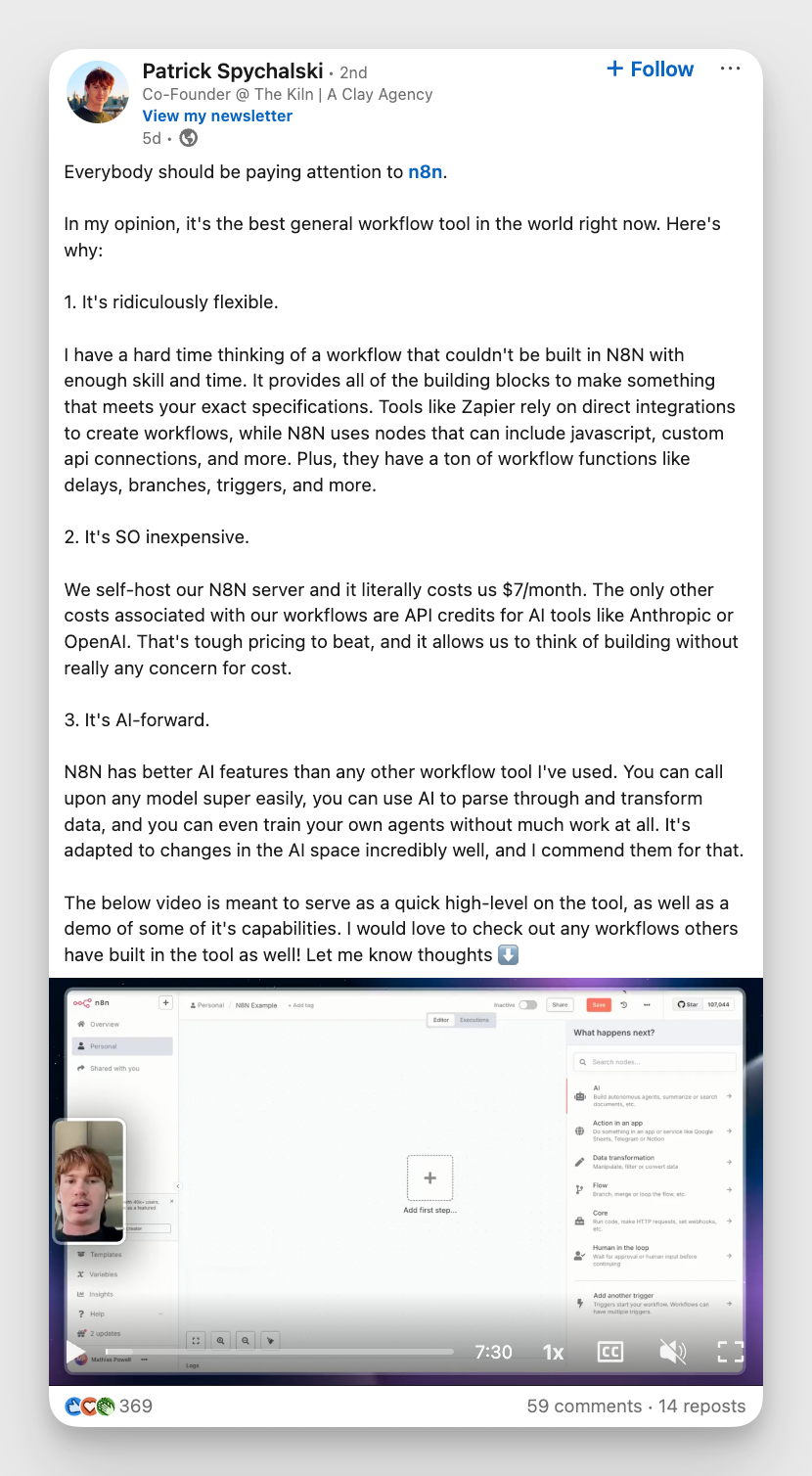
If you are just getting started with influencer marketing, here are three common types of B2B influencers brands work with.
- Industry thought leaders and executives: These are well-known figures with strong reputations and large professional followings. Their insights shape industry trends, and their endorsement can build serious credibility for your brand.
- Subject matter experts and consultants: These influencers are valued for their deep expertise in specific domains. They may not have massive audiences, but they hold strong sway within tight, targeted communities, making them ideal for niche B2B campaigns
- Employee advocates and brand ambassadors: Internal voices can be powerful too. When employees share authentic stories or expertise, they help humanize the brand and expand its reach organically. Customers trust real people over corporate logos.
How to create a pre-implementation plan for B2B influencer marketing campaigns?
You wouldn’t start a partnership without knowing what success looks like, and influencer marketing is no different. A well-thought-out pre-implementation plan sets the foundation for real impact.
First, define your core objective. Are you aiming for brand awareness (like driving visibility through LinkedIn shoutouts), lead generation (via co-branded webinars or gated content), or thought leadership (through long-form interviews or joint posts)? Clear goals shape the type of influencers you partner with and how you measure success.
Next, plan your budget and resources. Will you collaborate with high-profile thought leaders who charge premium rates or engage niche consultants with deep expertise? Don’t forget to allocate time for relationship-building and content coordination.
Without this upfront clarity, B2B influencer marketing can become vague and ineffective.
How to run a B2B influencer marketing campaign?
Instead of working with influencers in a haphazard manner, here’s a step-by-step process for launching your influencer marketing campaign.
#1. Conduct preliminary research
Before you get started with finalizing the concept of the campaign, here are three things you should research.
Industry and competitor analysis
Do a pulse check on your industry. What are the key conversations happening? Who's shaping them?
We regularly track both direct and indirect competitors. During a recent monthly audit, we spotted Hootsuite partnering with a few well-known B2B influencers.

That insight? Gold. As we plan to extend our marketing efforts and tap into influencer marketing, this insight gave us ideas on the kinds of influencers we could reach out to.
Target audience mapping
B2B influencer marketing only works if you know exactly who you're trying to influence. Start by mapping your target audience. Go beyond job titles and build detailed social media personas.
What kind of content draws them in? Where do they spend time online? And most importantly, who do they trust?
For example, if you're targeting mid-level marketing managers at SaaS companies, they’re probably following voices like Ross Simmonds or Peep Laja on LinkedIn.
Knowing this helps you target the right influencers, create the right kind of content, and build campaigns that feel natural.
Content themes and messaging approach
Before launching a B2B influencer campaign, research which content themes are already resonating with your target audience. What topics are influencers in your niche talking about? Should the tone be formal and insight-driven, or casual and conversational? Should the content educate, provoke, or inspire? What gets the most engagement — how-to guides or industry hot takes?
By identifying proven themes early on, you can craft content that feels relevant, valuable, and aligned with what your audience already cares about
#2. Find and shortlist influencers
Partnering with the wrong influencer can not only waste your budget but also your time. Here are two techniques we see brands using for researching influencers.
How to find influencers?
- Access industry event speaker lists: If someone’s speaking at major conferences or webinars, chances are they’re respected in their field and already influencing your target audience. These speakers often have deep expertise and engaged followings. You can check popular websites hosting events in your niche or search LinkedIn for event-related hashtags.
- Explore podcast guest appearances: Guests on niche B2B podcasts are typically invited for their insights and credibility. Plus, they’re comfortable creating content and sharing ideas, which are ideal traits for influencer partnerships. For example, here’s a list of speakers. For example, Ahrefs podcast gives me a list of influencers who are doing great in digital marketing.
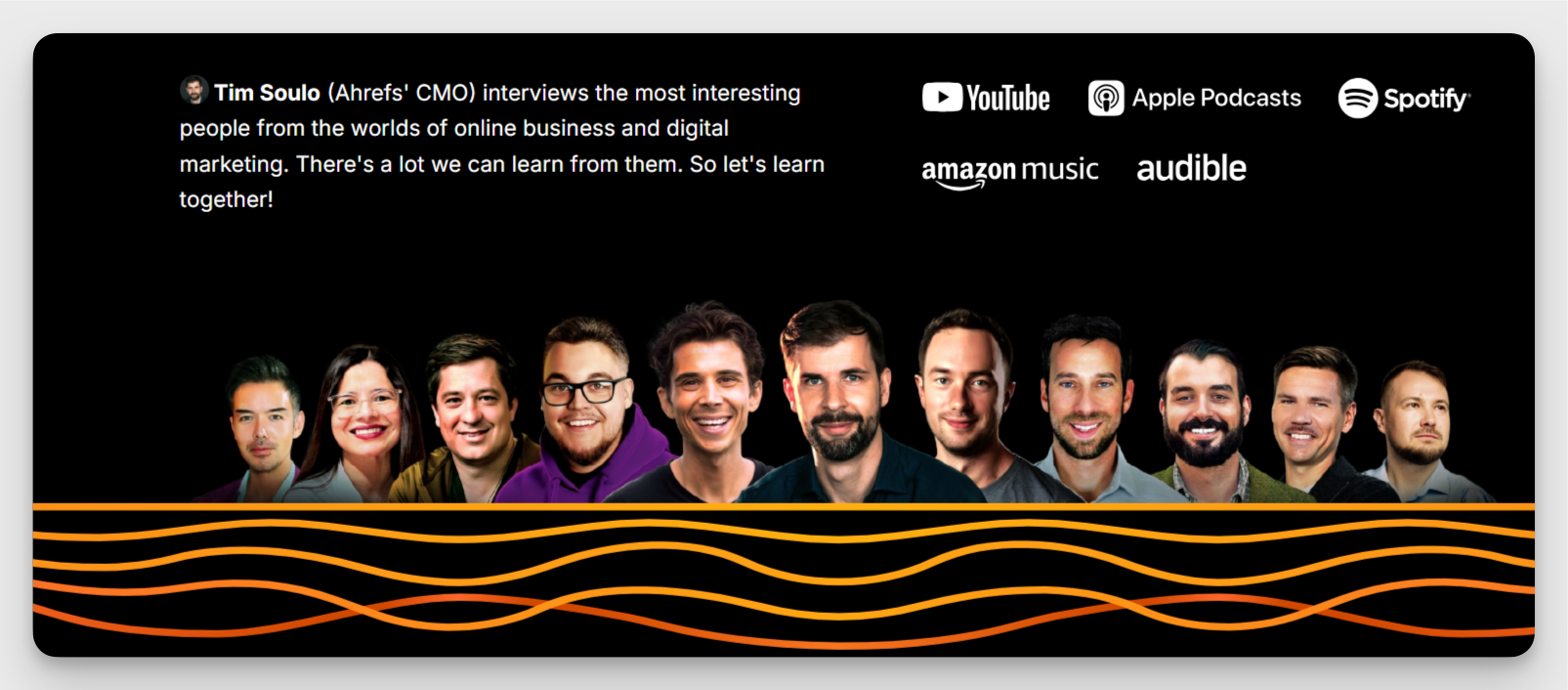
How to vet influencers?
A thorough vetting process helps ensure you're partnering with someone who not only looks good on paper but actually drives results. Here are four steps you should undertake.
- Assess audience quality: Are their followers relevant to your niche? Are they decision-makers or just passive scroll-bys?
- Analyze engagement rate: Run an influencer’s engagement analysis. Look at their engagement over the past year. If this reveals consistent interaction, it’s an encouraging sign. For example, Pretty Little Marketer is a B2B influencer with whom another one of our indirect competitors has partnered with. Using Socialinsider, we can see her profile’s engagement numbers over the last year.
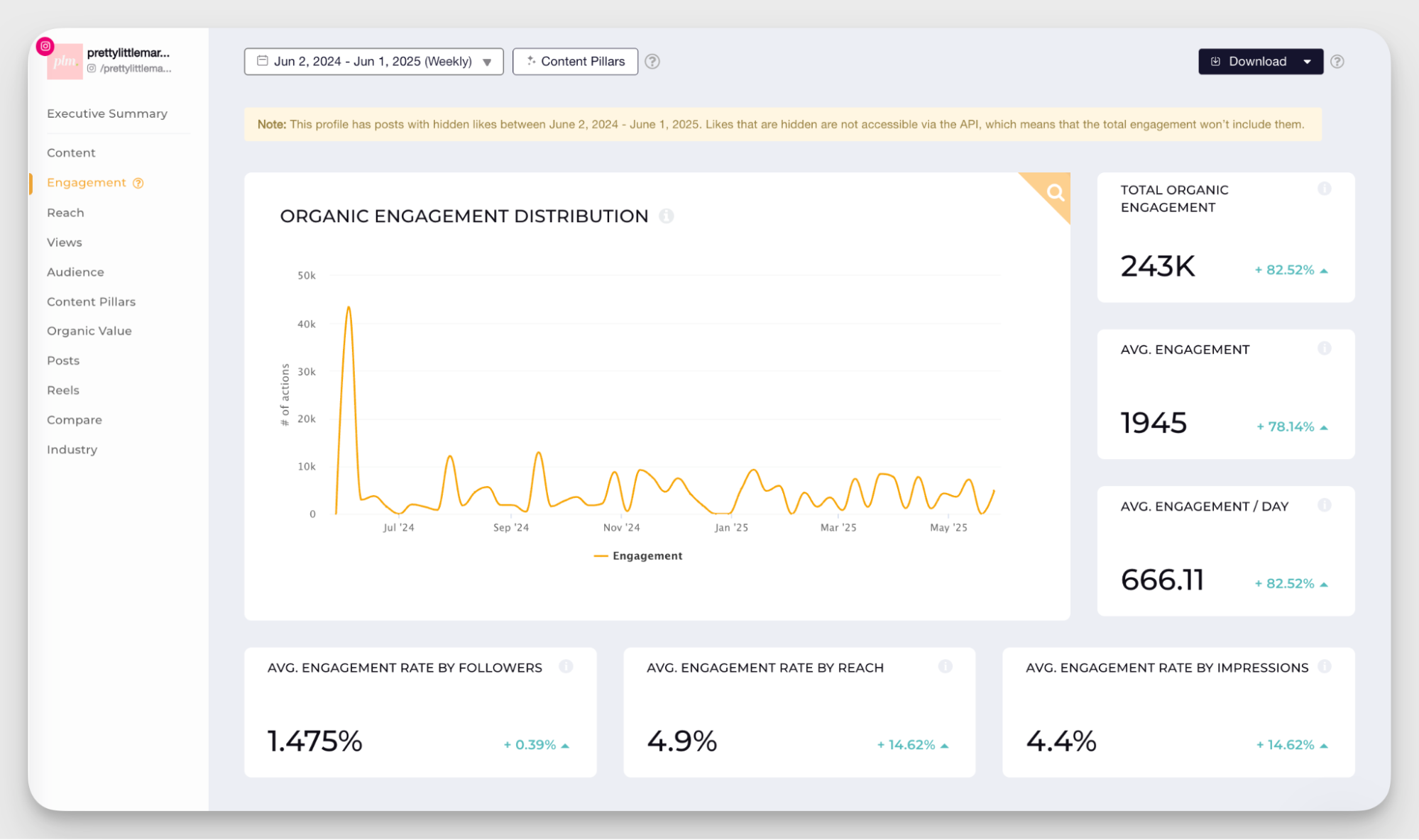
- Evaluate content alignment: Review their top-performing posts. Does the tone, style, and messaging match your brand? Here’s how Socialinsider can help with that.
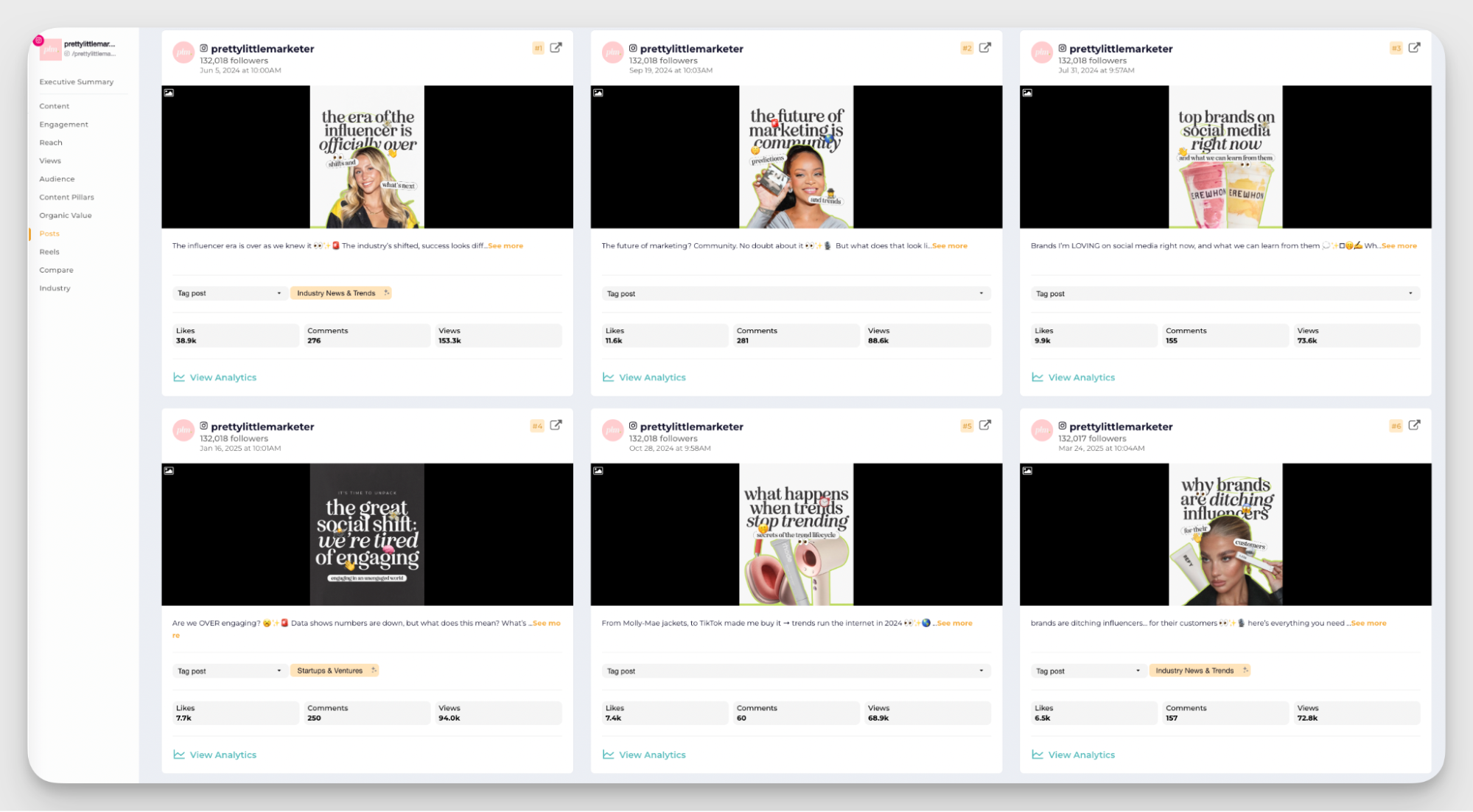
- Verify professional credibility: Check if they have spoken at events, written for respected publications, or been featured on industry podcasts.
How to use influencer scorecards and ranking systems to shortlist influencers?
Based on the data above, create a simple spreadsheet and assign scores (say, 1-5) across key criteria like audience relevance, engagement rate, content quality, platform fit, and professional credibility. Weigh each factor based on your goals. For example, give higher weight to audience relevance if lead generation is your priority.
Add a total score column to rank influencers. This helps remove bias and makes decision-making data-driven. For instance, an influencer with moderate reach but highly engaged, niche followers may score higher than others.
Update regularly as metrics evolve.
#3. Conduct outreach and focus on building long-term influencer relationships
Reaching out to B2B influencers isn’t about mass emails. It’s about relevance and relationship building.
Here’s an outreach email template you can customize and use.
Hi [First Name],
I’ve been following your content on [Platform]. Your recent post about [specific topic] really resonated with our team. It sparked some internal discussions around [related insight], and we’d love to explore ways to collaborate with you.
We’re working on [brief one-liner about your campaign or product], and I think your voice would add real value to the conversation. This could be through [e.g., co-branded content, product trial with feedback, or joint webinar], happy to tailor it to what works best for you.
Would you be open to a quick call or chat to explore this?
Looking forward to connecting,
[Your Name]
[Your Company]
[Your LinkedIn or Website link]
If you’re using LinkedIn, we recommend using smart LinkedIn connection strategies. For example, don’t pitch immediately. Engage with their posts, leave thoughtful comments, and build familiarity before sliding into their inbox.
Most importantly, use a value-first approach. Instead of asking for a favor, offer something useful. This could be early access to your product, co-branded content ideas, or speaking opportunities.
Once the outreach is done, you may need to negotiate and draft a contract. Here are some contract essentials you shouldn’t miss out on.
- Deliverables and timelines: Clearly define what content will be created (LinkedIn posts, videos, webinars) and when each deliverable is due.
- Usage rights and ownership: Specify where and how the content can be used (repurposed for ads, shared on company channels) and who owns it after publication.
- Compensation and payment terms: Outline the payment amount, method, and schedule (upfront, milestone-based, or post-delivery).
- Disclosure and compliance: Ensure the influencer agrees to follow relevant disclosure guidelines (#ad, #sponsored) as per platform and legal requirements.
- Performance expectations and reporting: Include benchmarks or expectations for engagement and agree on how results will be reported.
#4. Start planning the influencer campaign
Before you plan the content, pick a format that your audience generally interacts with. Here are some suggestions for your content strategy.
- Thought leadership articles: Great for building credibility, these long-form pieces let influencers share deep insights while aligning with your brand’s perspective. We regularly co-create articles like these to drive awareness and authority.
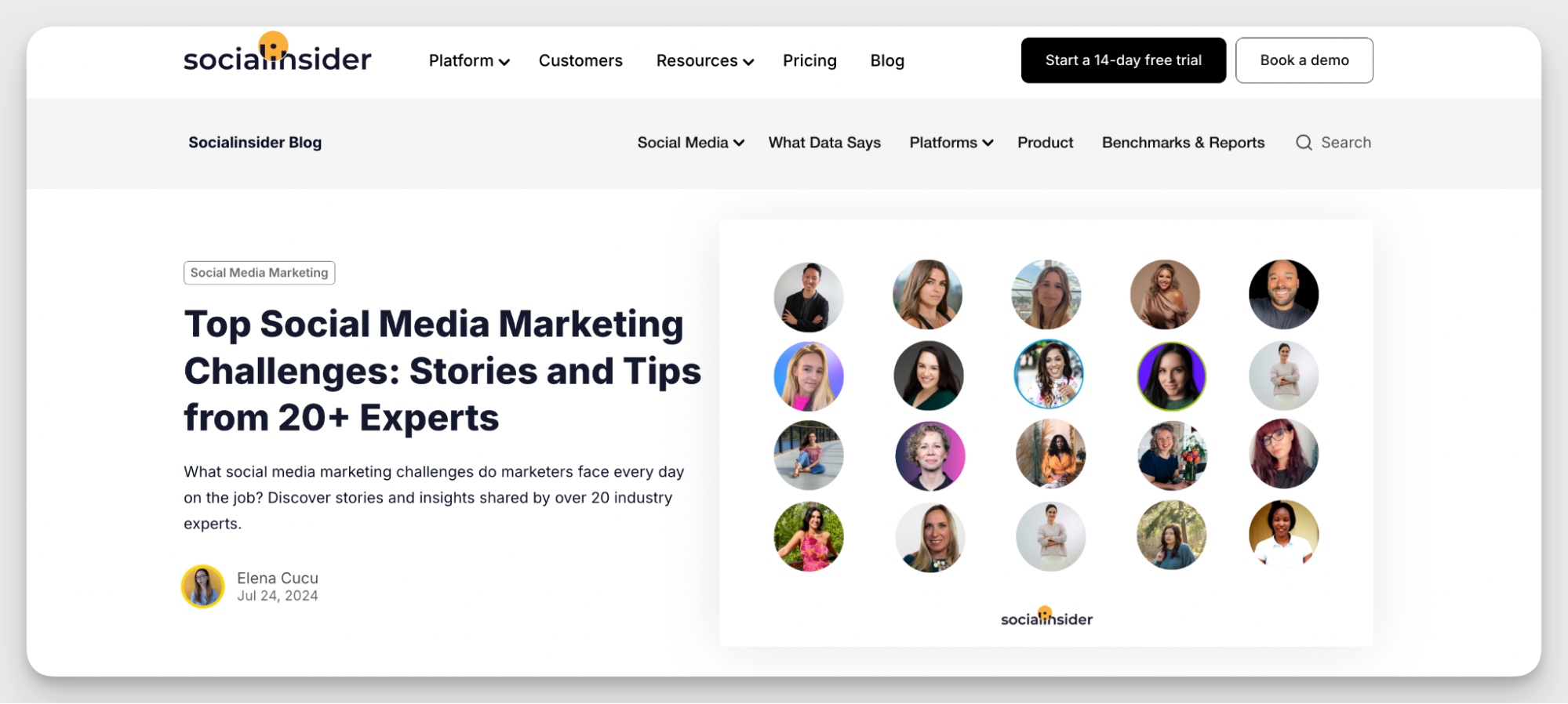
- Webinars and virtual events: This format is ideal for driving engagement and leads. Invite influencers to speak, moderate, or co-host; their presence boosts both attendance and trust.
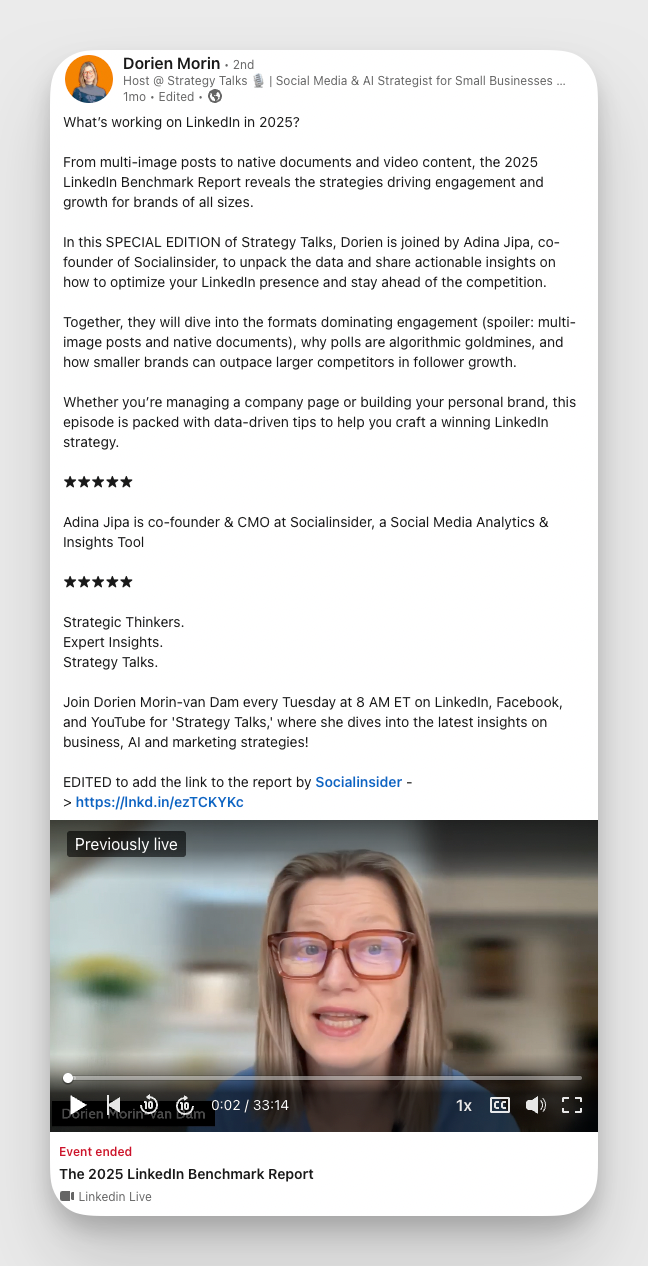
- LinkedIn video content: This is perfect for short, high-impact messaging. Influencers can share product use cases, tips, or opinions directly with a professional audience.
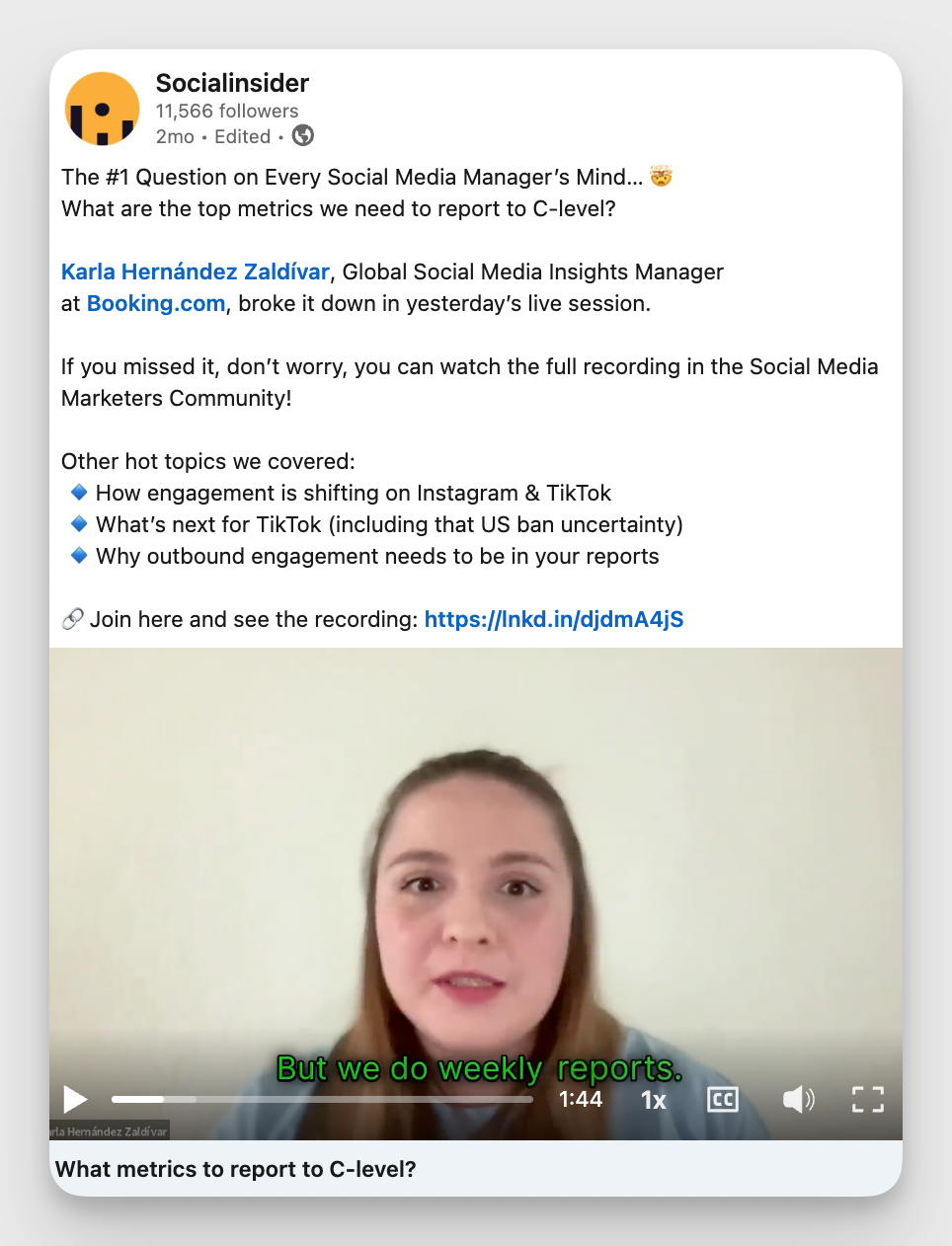
- Case studies and whitepapers: Ask influencers to share their insights on your original data reports or case studies. This adds credibility and makes technical content more relatable and shareable.
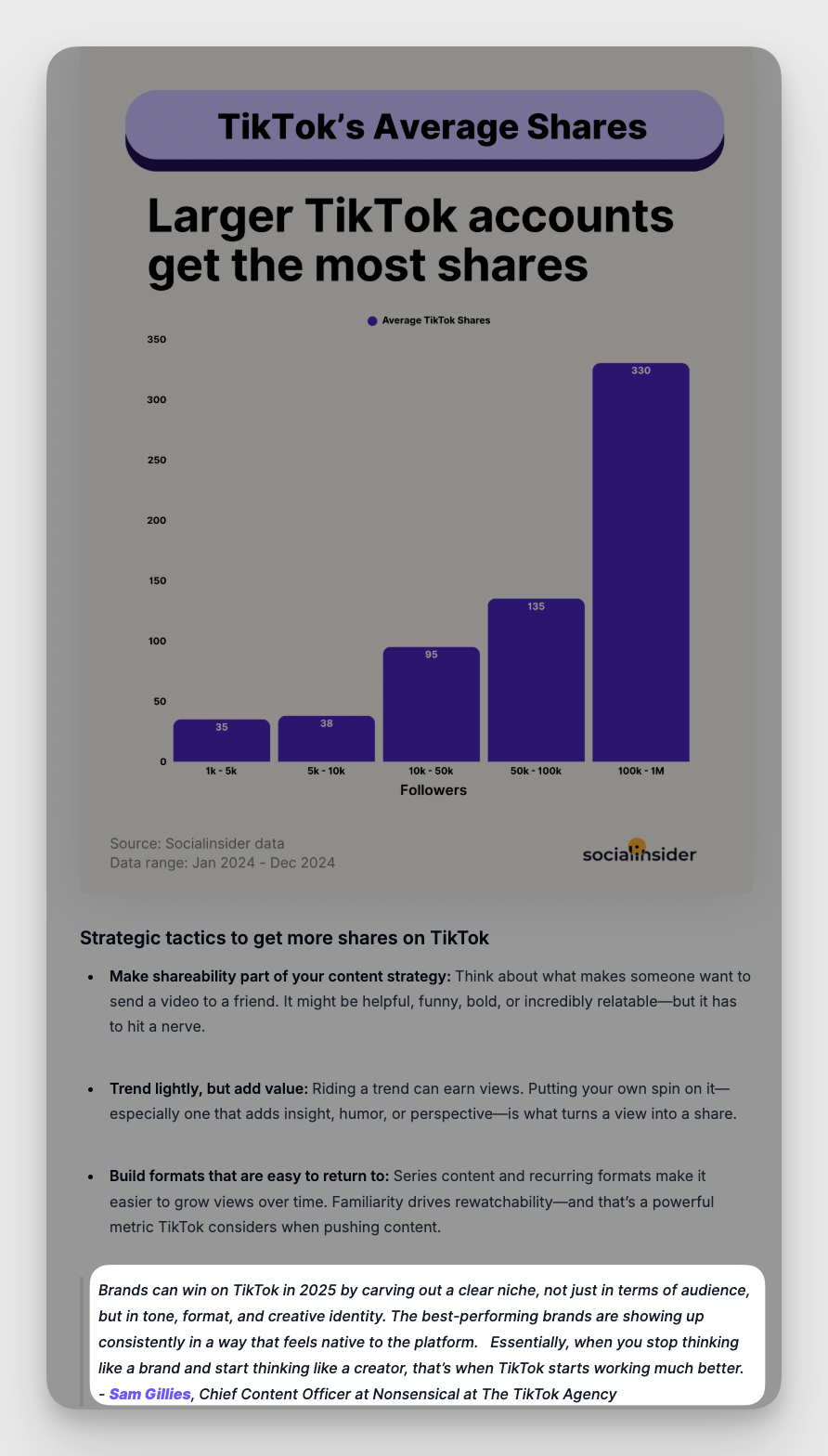
Develop a content calendar
Once the content format is selected, round up all the influencer collaboration posts in one calendar. This helps you stay organized, maintain consistency, and ensure that content aligns with key product launches, campaigns, or events. Map out not just the publish dates, but also timelines for content creation, review, and approval.
Include important details like platform, influencer name, post type, CTA, and supporting assets. For example, if you're co-hosting a webinar with an influencer, schedule promotion slots across LinkedIn, email, and blog in the weeks leading up.
Set up brand guidelines and messaging alignment
Before launching any influencer content, it’s crucial to align on brand voice, tone, and key messaging. Share a simple brand guideline doc that includes your preferred language style, core value propositions, and non-negotiable do’s and don’ts.
For example, if you're a B2B SaaS company focused on data security, your messaging should emphasize trust, compliance, and technical reliability, without sounding overly complex. Make sure influencers understand your product’s positioning so they can communicate it naturally, in a way that resonates with their audience.
Also, clarify visual guidelines if needed, like logo usage or branded graphics. This ensures every piece of content feels cohesive while still allowing the influencer’s authentic voice to shine through.
Strategize for cross-platform content distribution
To maximize ROI from your B2B influencer collaborations, plan how the content will be distributed across multiple channels. Don’t limit it to just the influencer’s feed. Repurpose and amplify across your owned platforms too.
For example, if an influencer creates a LinkedIn video testimonial for your B2B SaaS tool, you can turn it into a short YouTube clip, embed it in blog posts, share it in email newsletters, or use quotes in paid ads targeting decision-makers.
Each platform has a different audience mindset, so tweak formats accordingly. A strong cross-platform B2B influencer marketing strategy ensures your content has a longer shelf life, reaches a broader audience, and delivers consistent messaging at every touchpoint.
#5. Move forward with the execution
Once everything is planned (formats, messaging, timelines), it’s time to move into execution. The key here is keeping things smooth, clear, and collaborative.
Start by setting communication protocols with influencers. Decide how you’ll stay in touch — Slack, email, or a shared project board. Set expectations on response times, availability, and who’s the go-to contact from your side. This helps avoid delays and miscommunication, especially when multiple stakeholders are involved.
Next, establish a clear content approval process. Outline how drafts will be reviewed, who needs to approve them, and how many rounds of feedback are expected. Be respectful of the influencer’s voice, but ensure all content aligns with your brand and complies with platform and legal requirements.
For example, if an influencer is recording a product walkthrough video for your B2B platform, make sure the talking points are accurate and the demo reflects real product functionality. Allow time for review, revisions, and any legal or compliance checks (especially in regulated industries).
Smooth execution depends on clarity and mutual respect. Keep the lines of communication open, give feedback constructively, and stay flexible when needed.
#6. Measure the success of your campaign
Once your B2B influencer marketing campaign is executed, it’s time to measure whether it brought you significant results.
Awareness metrics
Track these key awareness metrics to understand how well your influencer campaigns are expanding your brand’s visibility:
- Reach: Measures the total number of unique users who saw the influencer’s content. Helps gauge how far your message traveled.
- Impressions: Counts how many times the content was displayed (even if to the same person). Useful for understanding content exposure and frequency.
- Share of Voice (SOV): Compares your brand’s mentions to competitors within a niche or keyword category. A rising SOV after influencer activity signals growing brand presence.
To analyze influencer’s posts strictly related to your brand, you can use Socialinsider’s manual tagging feature to tag specific posts, create a content pillar, and see aggregated data for that campaign.
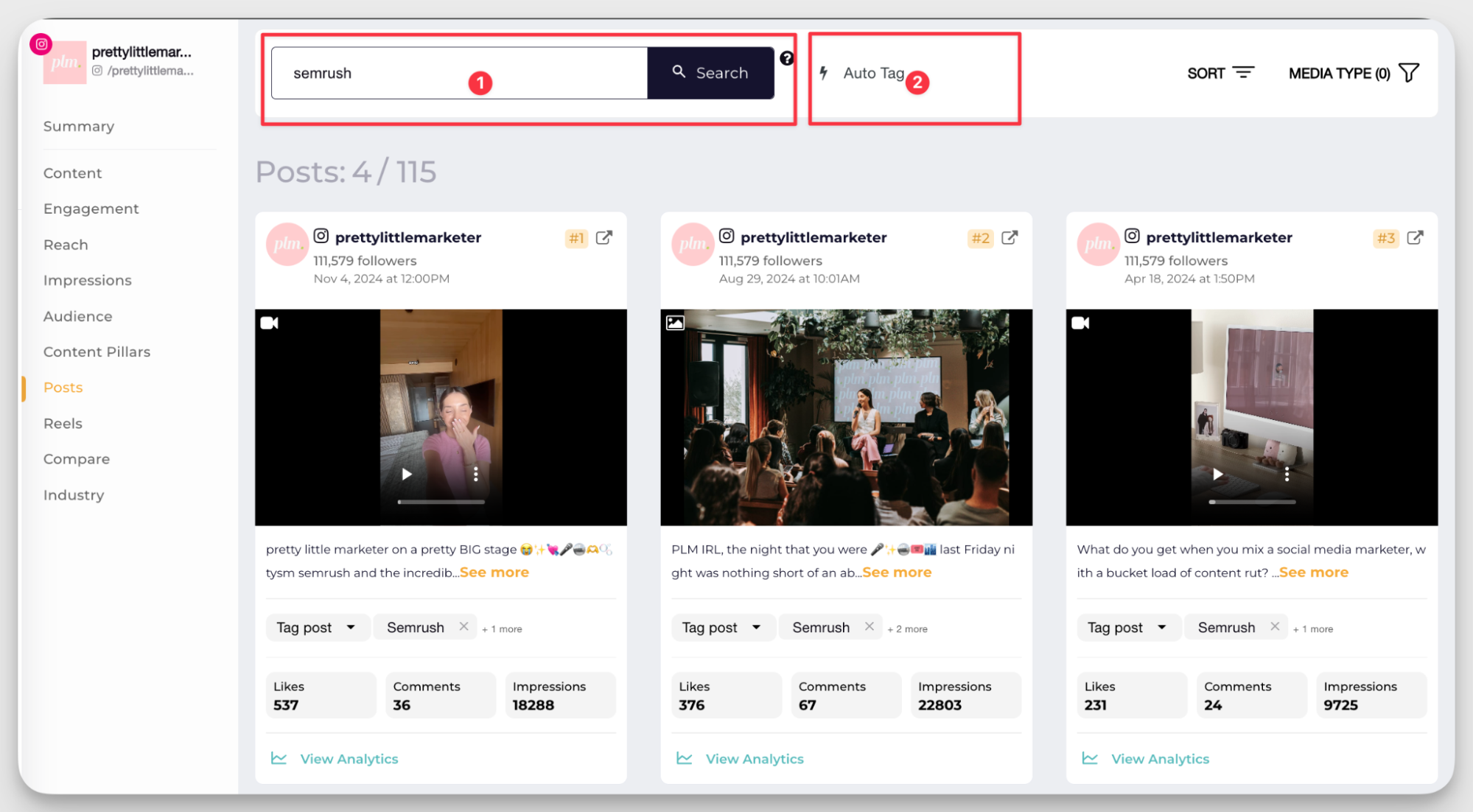
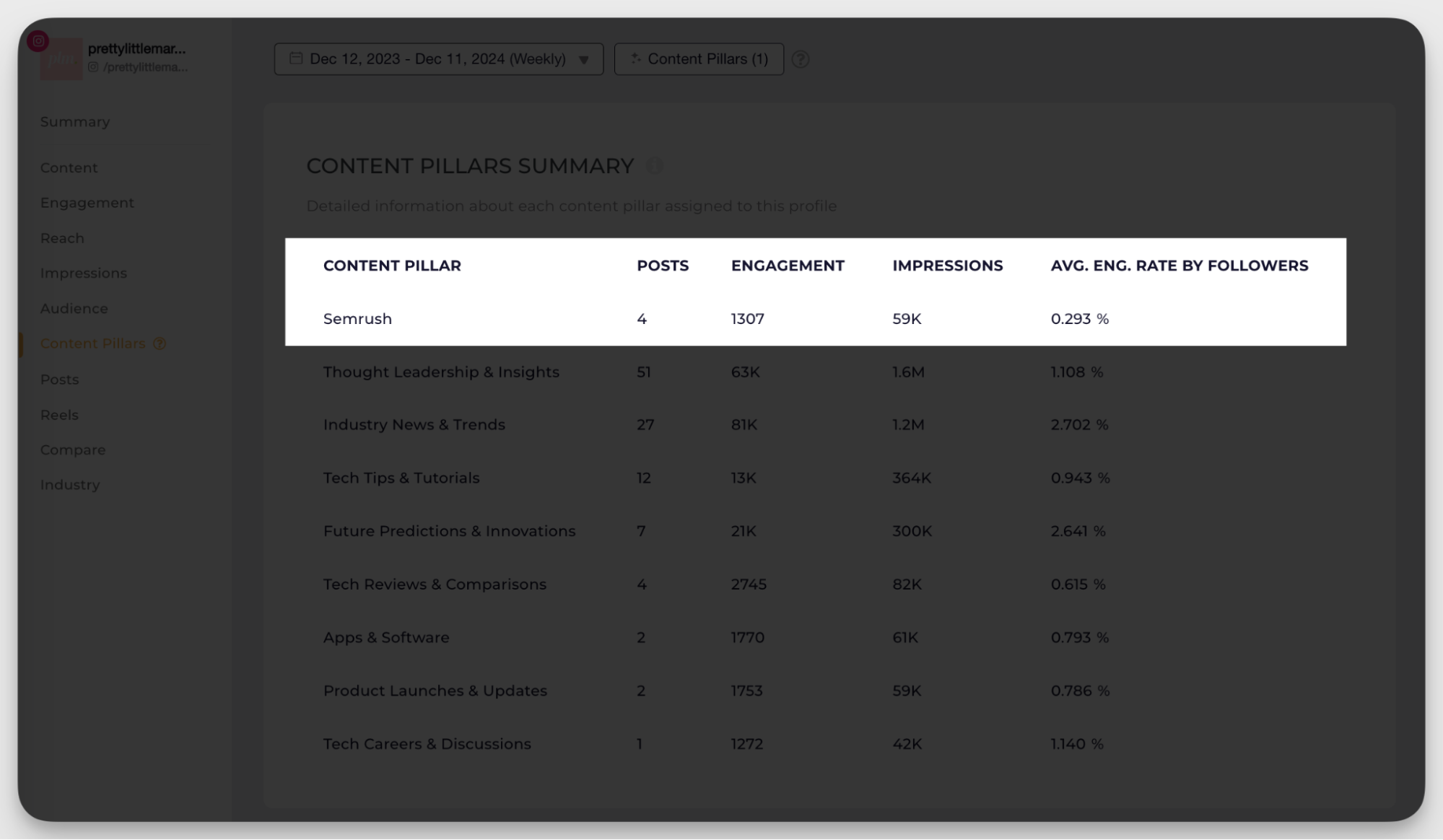
Engagement metrics
Engagement metrics reveal how your audience is interacting with influencer content, which is key for understanding interest and resonance:
- Comments: Show how well the content sparked conversation. More thoughtful or in-depth replies often signal higher relevance and trust.
- Shares: Indicate that the content is valuable enough for users to pass along. A strong sign of credibility and reach beyond the original audience.
- Saves: Suggests long-term value that the users plan to revisit the content later. This is especially useful for educational or insight-driven B2B posts.
For the same influencer, here’s how you can see individual post-level data.
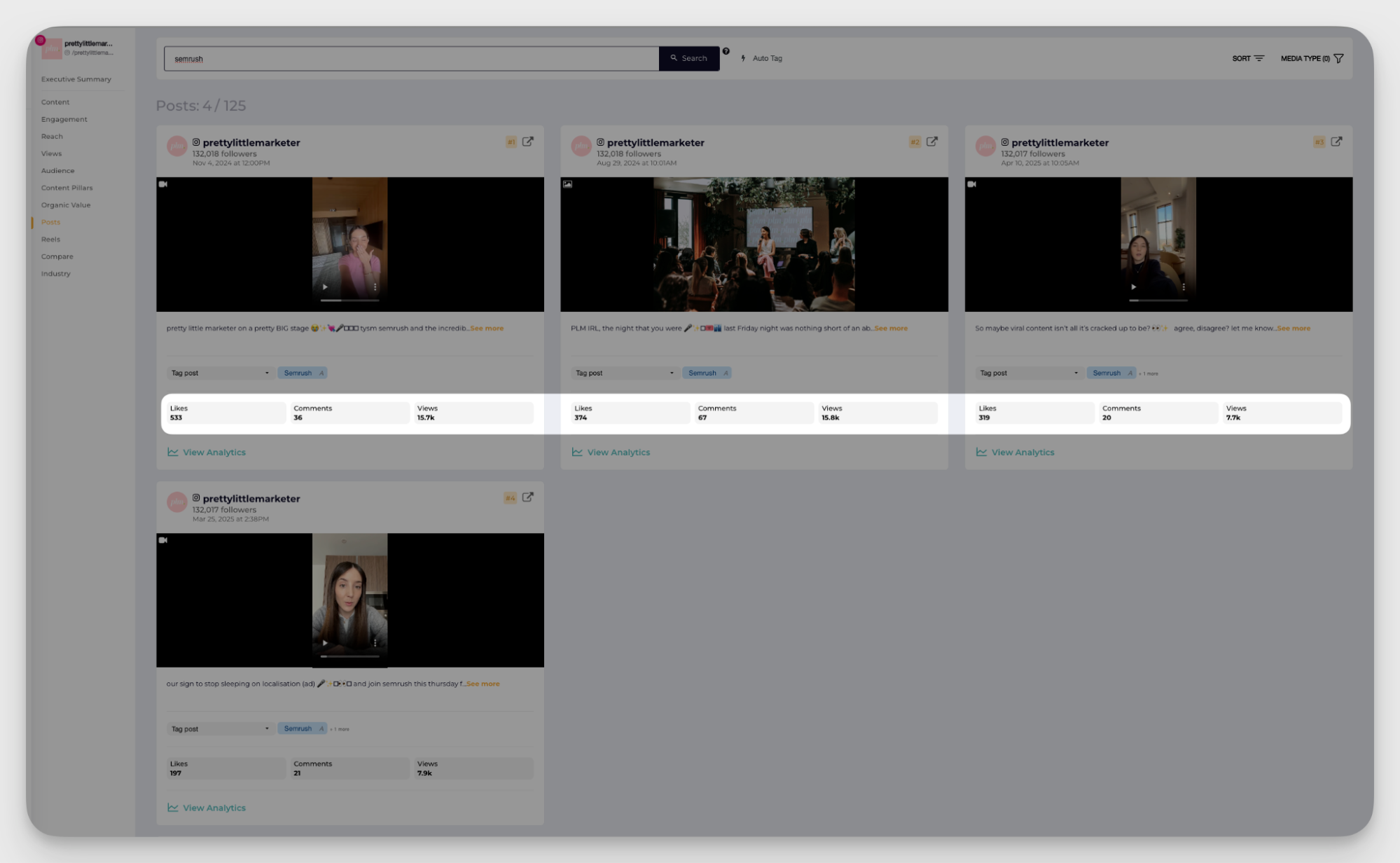
Lead generation metrics
Lead generation metrics help you track how influencer content contributes to actual business outcomes:
- Marketing Qualified Leads (MQLs): Leads who’ve engaged with influencer-driven content (for example, downloaded a guide or signed up for a webinar) and fit your ideal customer profile. A sign that the campaign is attracting the right audience.
- Sales Qualified Leads (SQLs): MQLs that show intent to buy and are ready for sales outreach. Indicates the influencer not only drove interest but also trust and action.
- Pipeline contribution: Measures how much influencer-attributed leads contribute to your total sales pipeline in value. The ultimate indicator of campaign impact on revenue.
Sales metrics
Sales metrics show the direct revenue impact of your influencer campaigns. These can be the most critical social media metrics for proving ROI in B2B:
- Closed deals: Tracks the number of deals that originated or were influenced by influencer-driven leads. Helps you connect specific content or collaborations to real sales outcomes.
- Revenue attribution: Measures the total revenue generated from influencer-attributed leads. Use tracking links, UTM parameters, or CRM tagging to link influencer content to closed revenue.
Tools and platforms for measurement
You don’t want to waste weeks or even days measuring the results of your influencer marketing for B2B campaigns. Analytics tools make this work easier for you. Let’s explore four of these tools and how you can utilize them.
Socialinsider — for social media analysis
Socialinsider is a powerful analytics tool that helps you track performance across Instagram, LinkedIn, Twitter, and Facebook, perfect for influencer campaign reporting. You can compare influencer posts against industry benchmarks, analyze engagement trends, and track branded content effectiveness over time.
For B2B campaigns, its LinkedIn post analytics are especially useful, showing impressions, reactions, and follower growth. You can also create custom reports to share campaign results with stakeholders. If you want to understand what worked and why it worked, Socialinsider is your go-to tool.
Heepsy — for discovering influencers
Heepsy is built for influencer discovery with precision. You can search for influencers based on niche, audience size, location, engagement rate, and even audience authenticity. For B2B brands targeting niche markets, say, fintech influencers in London or SaaS voices in North America, Heepsy helps narrow the field quickly.
It also offers audience insights to ensure the influencer’s followers align with your target buyer persona. This makes it especially useful in the early research and vetting phase of influencer marketing.

Refersion — for tracking influencer-driven sales and payouts
Refersion is ideal for performance-based influencer campaigns. It helps you set up custom affiliate programs, track sales generated by each influencer, and automatically calculate commissions.
For B2B brands offering SaaS subscriptions or product trials, you can create unique tracking links and coupon codes for each influencer. The platform gives you real-time reporting, so you know exactly which partnerships are converting and generating revenue.
Overall, Refersion makes it easy to turn influencer marketing from a branding activity into a measurable sales channel.

GRIN — for end-to-end platform for influencer marketing
GRIN is an all-in-one influencer marketing platform built for scale. You can discover influencers, send outreach emails, manage content approvals, track performance, and even process payments, without leaving the dashboard.
For B2B brands managing multiple influencer partnerships, GRIN simplifies workflows and centralizes everything. It also integrates with eCommerce and CRM platforms, making it easy to tie influencer efforts back to actual business metrics like MQLs or revenue.
If you're running long-term or high-volume influencer campaigns, GRIN can save hours and reduce chaos.
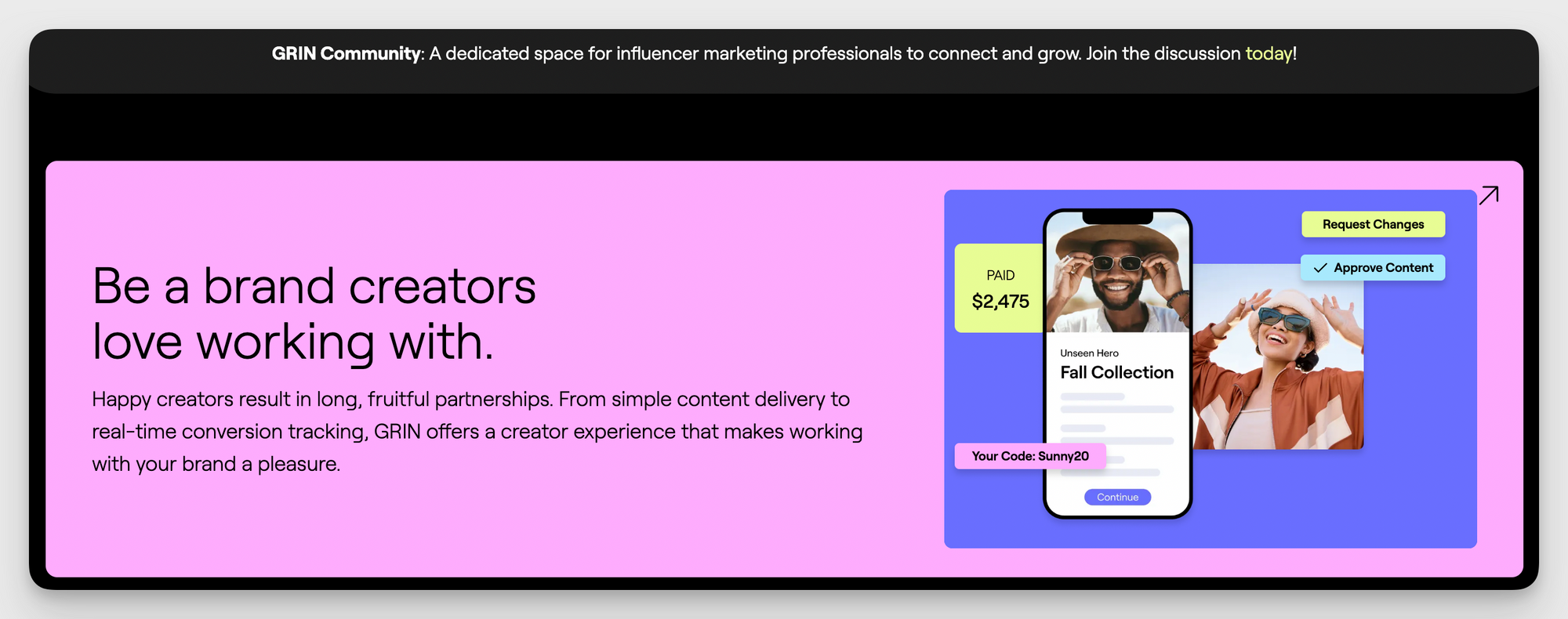
Create executive-ready reporting dashboards
At the final stage of your influencer marketing campaign, it’s crucial to present results in a way that decision-makers can quickly understand and act on. Build an executive-ready dashboard that highlights influencer marketing KPIs like reach and engagement.
Socialinsider makes this easy by offering ready-made dashboards and customizable reports across platforms like Instagram or TikTok. You can compare influencer content performance, benchmark against industry standards, and export clean, branded reports that are exec-ready in minutes.

You can also use the tool to preset visual graphs showing impressions, follower growth, and engagement trends. This gives leadership the clarity they need to see what’s working and why.
What are some advanced B2B influencer marketing tactics?
To make your influencer marketing campaigns even more powerful, here are three tactics you can implement.
Develop an employee advocacy program
According to Adobe’s report, their employee advocacy program led to a 25% increase in brand awareness and a 30% boost in employee engagement.
Now imagine this: your product manager shares a behind-the-scenes story about a recent feature launch on LinkedIn. It sparks conversations, attracts interest from potential customers, and positions your brand as both innovative and human. That’s the power of employee advocacy.
To launch your own program, start small:
- Choose 5-10 engaged team members to pilot the initiative.
- Provide them with branded assets, talking points, and content ideas.
- Encourage authenticity. Let them add their own voice and experiences.
- Track engagement and celebrate wins publicly.
With the right support, your team can become a trusted content engine and help drive reach, credibility, and connection far beyond what corporate channels can do alone.
Here’s how our team does it at Socialinsider.

Co-create thought leadership content
What happens when your brand’s expertise meets an influencer’s credibility? You get powerful, co-created thought leadership content.
Instead of asking influencers to just promote your product, collaborate with them to create something valuable. Say, a blog post, LinkedIn article, or industry report. This positions both your brand and the influencer as trusted voices in the space.
For example, partner on a “State of the Industry” post where your team provides data and the influencer adds insights or commentary. It’s a win-win: you get reach and relevance, they get quality content that boosts their thought leadership.
At Socialinsider, we also do this through our webinar series.

Run event and conference partnerships
Influencers aren’t just for online content. They can add real value to your B2B events and conferences too. Invite them to speak, host panels, or cover the event live on LinkedIn or X (Twitter). Their presence builds credibility, attracts their audience, and drives buzz before, during, and after the event.
For example, an influencer can moderate a session, interview your leadership team, or post key takeaways in real-time. You get fresh, engaging content, and they get visibility as a trusted voice in the industry.
To make it work, align on expectations early, provide access to behind-the-scenes content or product demos, and promote their involvement across all channels.
Examples of successful B2B influencer marketing campaigns
Here are two influencer partnership examples that will inspire you.
SAP’s #LifeAtSAP campaign
Goal: Humanize the SAP brand and boost employer branding
Enterprise tech brands often struggle to feel relatable. SAP set out to change that by showcasing the people behind the product to attract top talent and shift perceptions from “corporate giant” to “innovative, people-first employer.”
Execution: Partnered with employees and B2B influencers for authentic storytelling
Instead of polished corporate messaging, SAP activated employee advocates and trusted B2B influencers to share real stories from inside the company. Using the hashtag #LifeAtSAP, they posted behind-the-scenes content, from daily routines and office culture to career growth tips, bringing the brand’s human side to life.
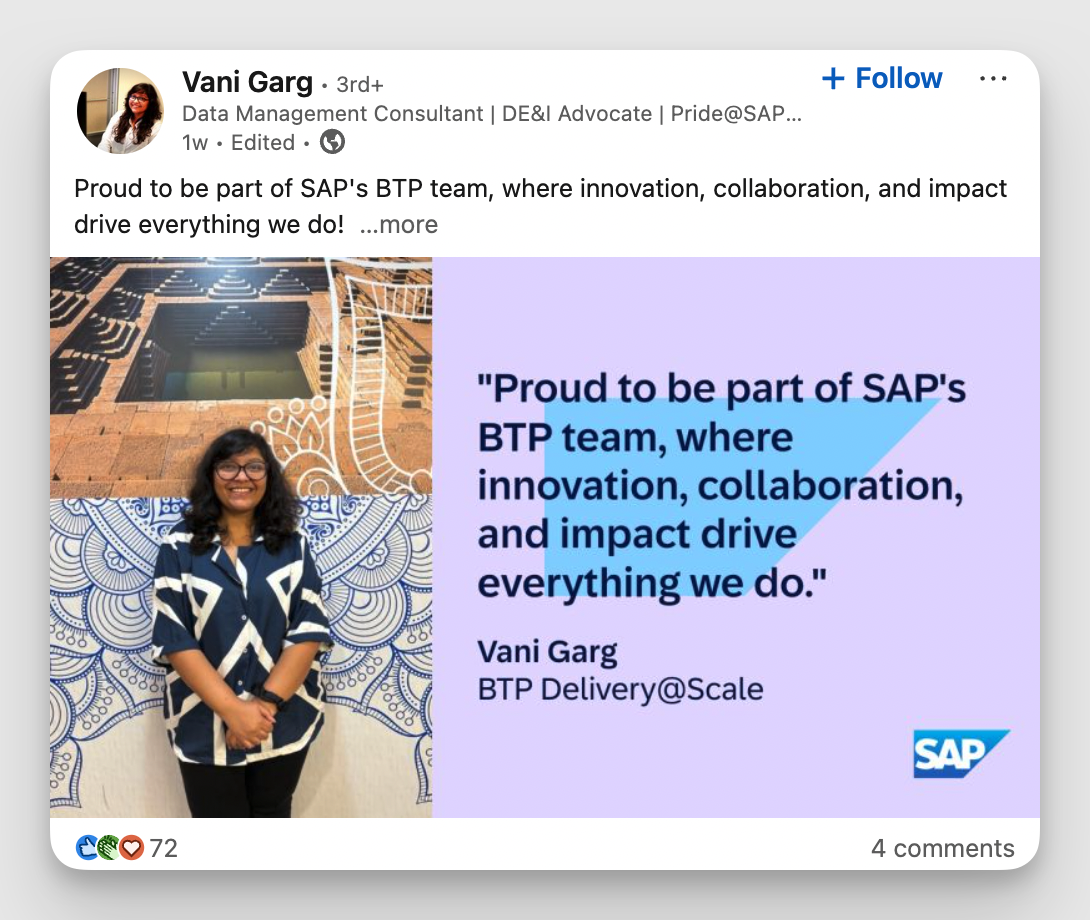
Channels: LinkedIn, X, Instagram
They focused on the platforms where professionals and potential hires already spend time, especially LinkedIn, with additional reach via Twitter and Instagram.
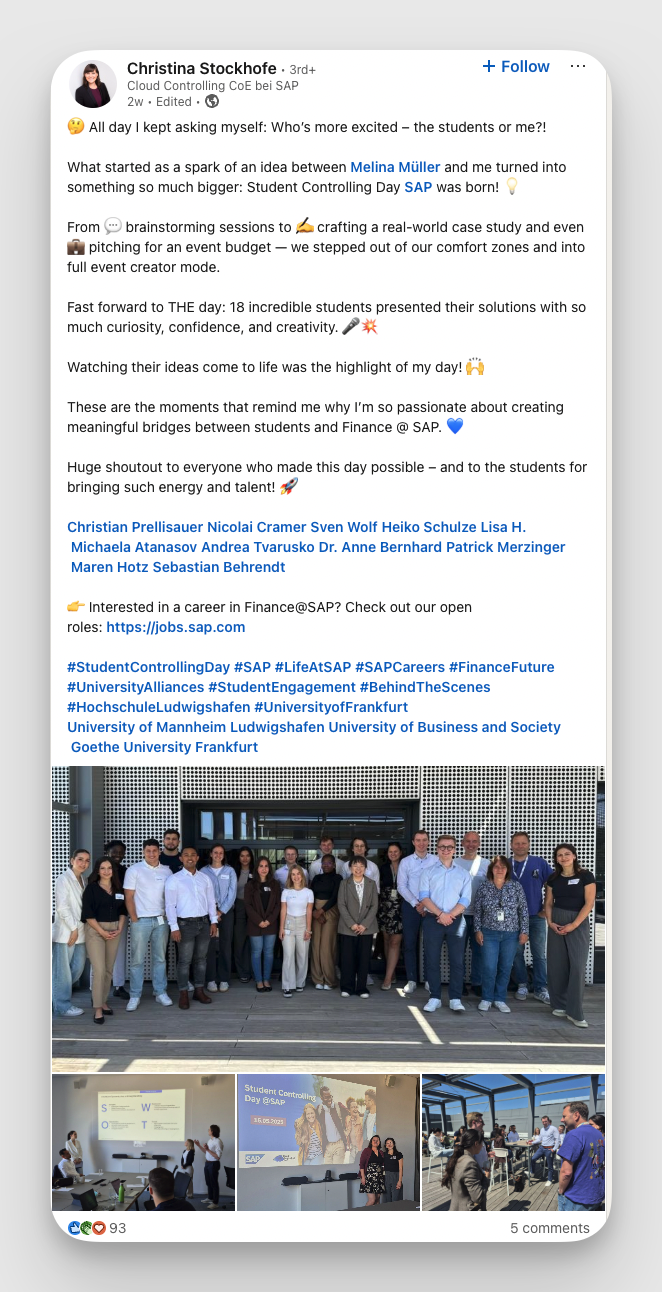
Results: Higher engagement, stronger talent pipeline, improved brand perception
The campaign led to a noticeable spike in engagement and employer interest, while also positioning SAP as a modern, inclusive workplace. It’s a smart example of how B2B influencer marketing can support not only sales but also recruitment and brand trust.
Cisco’s IT influencer program
Goal: Boost awareness of enterprise solutions among IT professionals
Cisco wanted to reach a highly technical, discerning audience — IT decision-makers who don’t respond to flashy ads, but to trusted, peer-level voices. The goal was to increase awareness and trust around their enterprise solutions in areas like security, networking, and infrastructure.
Execution: Build long-term partnerships with respected IT influencers
Rather than short-term promotions, Cisco focused on long-term relationships with credible voices in the IT space, like Chuck Hollis and Ethan Banks, well-known bloggers and podcast hosts. These influencers created deep-dive content, shared hands-on experiences, participated in product launches, and even spoke at Cisco-hosted events and panels.
The strategy wasn’t to push products. It was to start conversations, share insights, and build technical credibility through people the audience already trusted.
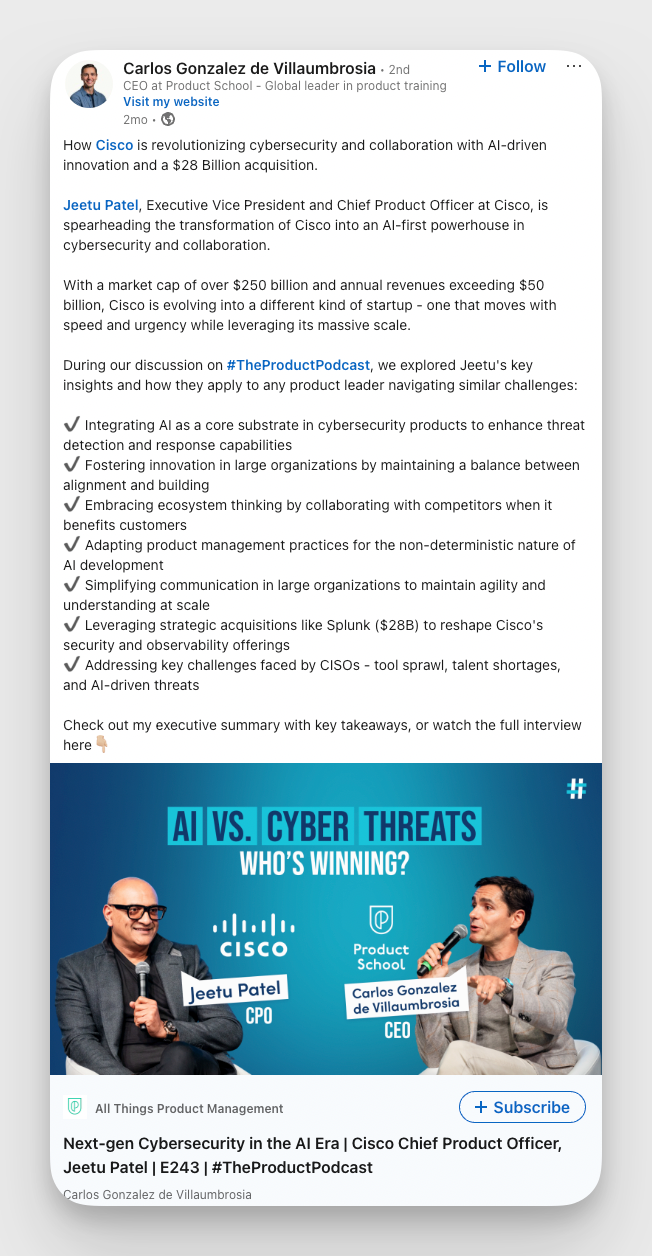
Channels: Blogs, podcasts, LinkedIn, YouTube
Cisco leveraged platforms where IT professionals spend their time researching and learning. Blog posts offered technical breakdowns, podcasts sparked thoughtful discussions, LinkedIn helped reach professional circles, and YouTube brought in visual demonstrations and event highlights.
Results: Strengthened Cisco’s leadership position and peer-level engagement
The program positioned Cisco as not just a tech vendor, but a respected thought leader. By leveraging influencer expertise, they built trust, drove engagement, and deepened relationships within the IT community.
Common misconceptions about B2B influencer marketing
B2B influencer marketing isn’t just for trendy products or Instagram stars. Yet many brands still misunderstand how it really works. Here are three such misconceptions.
- Influencer marketing is only for B2C brands: Not at all. B2B influencer marketing targets professional audiences with credible voices who understand industry challenges. It’s about building trust and authority, not viral trends.
- Influencer marketing is only about one-off campaigns: Effective B2B influencer marketing focuses on long-term relationships and ongoing collaboration to build sustained credibility and thought leadership.
- Influencer marketing does not really impact complex B2B sales. False. Influencers help educate multiple decision-makers, humanize brands, and guide prospects through extended sales cycles, ultimately driving leads and revenue.
Final thoughts
Influencer marketing in B2B is no longer a “nice to have”. It’s a powerful, strategic channel for building trust, driving awareness, and even generating leads. When done right, it goes beyond likes and impressions to spark real conversations and business impact.
The key is finding the right voices, aligning on goals, and measuring what truly matters.
Whether you're just starting out or scaling your program, data should guide every step. Tools like Socialinsider can help you track performance, benchmark content, and prove ROI with ease. Get started with a free account today.
Analyze your competitors in seconds
Track & analyze your competitors and get top social media metrics and more!
You might also like
Improve your social media strategy with Socialinsider!
Use in-depth data to measure your social accounts’ performance, analyze competitors, and gain insights to improve your strategy.


